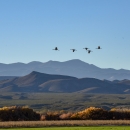Four populations of sandhill cranes are surveyed each year to estimate breeding population size: the Mid-Continent Population (MCP), in the High Plains U.S.; the Rocky Mountain Population (RMP), in the western U.S.; the Lower Colorado River Valley Population (LCRVP), primarily in northeast Nevada, and the Eastern Population (EP) in the Great Lake, Mid-Atlantic and Southeastern states. These populations are monitored through breeding and pre-migration surveys to provide information for harvest management. For the MCP, extensive, spring aerial surveys on major concentration areas that are corrected for observer visibility bias provide annual indices of abundance used to measure population trends. These surveys are conducted in late March, at a time when birds that wintered in Mexico, Arizona, New Mexico, and Texas usually have migrated northward to spring staging areas, but before spring "break-up" conditions allow cranes to move into Canada. A fall pre-migration survey is conducted by 5 states (UT, CO, ID, WY, and MT) for the RMP, to avoid counting cranes from other populations that comingle during the spring breeding period. The LCRVP is surveyed in winter by airplane at four major wintering areas in Arizona and California. The EP is surveyed by volunteers and agency personnel at staging areas in the fall to count cranes migrating from Canada. Survey areas include the Great Lakes (MN, WI, MI, OH, PA and IN), the Mid-Atlantic (KY and TN) and the Southeastern states (GA and FL).
Additional Information
- Sandhill Crane Population Status Report Library Collection - Annual population status and harvest reports
- Eastern Population of Greater Sandhill Crane Fall Survey Reports Library Collection - Annual reports that provide summary and survey results
- USFWS Eastern Population Sandhill Crane Data Portal - Survey description and an interactive observations map
- Coordinated Survey for Mid-Continent Population Sandhill Crane Reports Library Collection - Annual reports that summarize survey results and population status
- Rocky Mountain Population of Greater Sandhill Crane Survey Reports Library Collection - Annual reports that summarize survey results
- Lower Colorado River Valley Population - Abundance indices for this population can be found within the most recent Pacific Flyway data book





